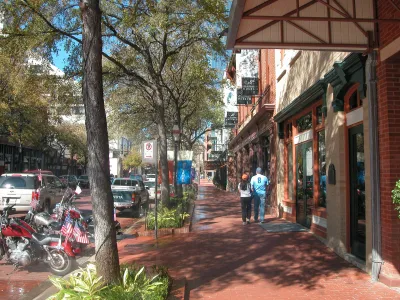The Texas city is the largest municipality so far to sign onto the Blue Zones Project, an initiative for improving longevity. In a nutshell, Blue Zones wants to make healthy choices the easy ones.

Recently adopted in Fort Worth, the Blue Zones Project "aims to 'reverse-engineer longevity' into a community by promoting a number of principles gleaned from National Geographic explorer Dan Buettner's observations of healthy and long-lived communities around the globe."
Inspired by Buettner's findings from five places where people tend to live to age 100, Blue Zones encourages movement toward a "tipping point" where healthy becomes the default choice. Fort Worth "needs to get 111,000 people 15 and older to sign the personal pledge, 25 percent of schools, and enough employers to represent 85,000 employees."
Program coordinators emphasize that the project isn't about making people do anything. Instead, Blue Zones seeks healthy infrastructure improvements where possible, including changes to the built environment favoring walkability, healthy eating, and physical movement.
In conjunction with this effort, Fort Worth "has introduced WalkFW, a pedestrian transportation plan, and a new bicycle and pedestrian advisory committee is working on improvements to a 2010 cycling plan. The city is also working on a complete streets program as well as considering a program that would let vendors take produce carts into food deserts."
FULL STORY: City of Fort Worth Hopes to Get People Walking Till They’re 100

National Parks Layoffs Will Cause Communities to Lose Billions
Thousands of essential park workers were laid off this week, just before the busy spring break season.

Retro-silient?: America’s First “Eco-burb,” The Woodlands Turns 50
A master-planned community north of Houston offers lessons on green infrastructure and resilient design, but falls short of its founder’s lofty affordability and walkability goals.

Delivering for America Plan Will Downgrade Mail Service in at Least 49.5 Percent of Zip Codes
Republican and Democrat lawmakers criticize the plan for its disproportionate negative impact on rural communities.

Test News Post 1
This is a summary

Test News Headline 46
Test for the image on the front page.

Balancing Bombs and Butterflies: How the National Guard Protects a Rare Species
The National Guard at Fort Indiantown Gap uses GIS technology and land management strategies to balance military training with conservation efforts, ensuring the survival of the rare eastern regal fritillary butterfly.
Urban Design for Planners 1: Software Tools
This six-course series explores essential urban design concepts using open source software and equips planners with the tools they need to participate fully in the urban design process.
Planning for Universal Design
Learn the tools for implementing Universal Design in planning regulations.
EMC Planning Group, Inc.
Planetizen
Planetizen
Mpact (formerly Rail~Volution)
Great Falls Development Authority, Inc.
HUDs Office of Policy Development and Research
NYU Wagner Graduate School of Public Service





























